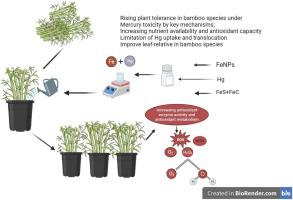当前位置:
X-MOL 学术
›
Ecotox. Environ. Saf.
›
论文详情
Our official English website, www.x-mol.net, welcomes your feedback! (Note: you will need to create a separate account there.)
Iron nanoparticles in combination with other conventional Fe sources remediate mercury toxicity-affected plants and soils by nutrient accumulation in bamboo species
Ecotoxicology and Environmental Safety ( IF 6.8 ) Pub Date : 2024-05-07 , DOI: 10.1016/j.ecoenv.2024.116431 Abolghassem Emamverdian , Ahlam Khalofah , Necla Pehlivan , Yang Li , Moxian Chen , Guohua Liu
Ecotoxicology and Environmental Safety ( IF 6.8 ) Pub Date : 2024-05-07 , DOI: 10.1016/j.ecoenv.2024.116431 Abolghassem Emamverdian , Ahlam Khalofah , Necla Pehlivan , Yang Li , Moxian Chen , Guohua Liu

|
The issue of mercury (Hg) toxicity has recently been identified as a significant environmental concern, with the potential to impede plant growth in forested and agricultural areas. Conversely, recent reports have indicated that Fe, may play a role in alleviating HM toxicity in plants. Therefore, this study's objective is to examine the potential of iron nanoparticles (Fe NPs) and various sources of Fe, particularly iron sulfate (Fe SO or Fe S) and iron-ethylene diamine tetra acetic acid (Fe - EDTA or Fe C), either individually or in combination, to mitigate the toxic effects of Hg on Involved mechanisms in the reduction of Hg toxicity in one-year bamboo species by Fe NPs, and by various Fe sources were introduced by a controlled greenhouse experiment. While 80 mg/L Hg significantly reduced plant growth and biomass (shoot dry weight (36%), root dry weight (31%), and shoot length (31%) and plant tolerance (34%) in comparison with control treatments, 60 mg/L Fe NPs and conventional sources of Fe increased proline accumulation (32%), antioxidant metabolism (21%), polyamines (114%), photosynthetic pigments (59%), as well as root dry weight (25%), and shoot dry weight (22%), and shoot length (22%). Fe NPs, Fe S, and Fe C in plant systems substantially enhanced tolerance to Hg toxicity (23%). This improvement was attributed to increased leaf-relative water content (39%), enhanced nutrient availability (50%), improved antioxidant capacity (34%), and reduced Hg translocation (6%) and accumulation (31%) in plant organs. Applying Fe NPs alone or in conjunction with a mixture of Fe C and Fe S can most efficiently improve bamboo plants' tolerance to Hg toxicity. The highest efficiency in increasing biochemical and physiological indexes under Hg, was related to the treatments of Fe NPs as well as Fe NPs + FeS + FeC. Thus, Fe NPs and other Fe sources might be effective options to remove toxicity from plants and soil. The future perspective may help establish mechanisms to regulate environmental toxicity and human health progressions.
中文翻译:

铁纳米粒子与其他传统铁源相结合,通过竹子中的养分积累来修复受汞毒性影响的植物和土壤
汞(Hg)毒性问题最近被认为是一个重大的环境问题,有可能阻碍森林和农业地区的植物生长。相反,最近的报告表明,Fe 可能在减轻植物中的重金属毒性方面发挥作用。因此,本研究的目的是检查铁纳米粒子(Fe NP)和各种铁来源的潜力,特别是硫酸铁(Fe SO 或 Fe S)和铁-乙二胺四乙酸(Fe - EDTA 或 Fe C),单独或组合,以减轻汞对一年生竹种汞毒性的影响,通过受控温室实验引入了铁纳米颗粒和各种铁源降低汞毒性的机制。与对照处理相比,80mg/L Hg 显着降低了植物生长和生物量(茎干重 (36%)、根干重 (31%)、茎长 (31%) 和植物耐受性 (34%),60 mg/L Fe NPs 和常规铁源增加了脯氨酸积累 (32%)、抗氧化代谢 (21%)、多胺 (114%)、光合色素 (59%) 以及根干重 (25%),植物系统中的芽干重(22%)和芽长度(22%)显着增强了对汞毒性的耐受性(23%)。 (39%),提高养分利用率 (50%),提高抗氧化能力 (34%),并减少植物器官中汞的易位 (6%) 和积累 (31%)。 Fe C和Fe S可以最有效地提高竹子对汞毒性的耐受性。 Hg作用下生化和生理指标的提高效率最高,与Fe NPs以及Fe NPs + FeS + FeC的处理有关。因此,铁纳米粒子和其他铁源可能是消除植物和土壤毒性的有效选择。未来的前景可能有助于建立调节环境毒性和人类健康进展的机制。
更新日期:2024-05-07
中文翻译:

铁纳米粒子与其他传统铁源相结合,通过竹子中的养分积累来修复受汞毒性影响的植物和土壤
汞(Hg)毒性问题最近被认为是一个重大的环境问题,有可能阻碍森林和农业地区的植物生长。相反,最近的报告表明,Fe 可能在减轻植物中的重金属毒性方面发挥作用。因此,本研究的目的是检查铁纳米粒子(Fe NP)和各种铁来源的潜力,特别是硫酸铁(Fe SO 或 Fe S)和铁-乙二胺四乙酸(Fe - EDTA 或 Fe C),单独或组合,以减轻汞对一年生竹种汞毒性的影响,通过受控温室实验引入了铁纳米颗粒和各种铁源降低汞毒性的机制。与对照处理相比,80mg/L Hg 显着降低了植物生长和生物量(茎干重 (36%)、根干重 (31%)、茎长 (31%) 和植物耐受性 (34%),60 mg/L Fe NPs 和常规铁源增加了脯氨酸积累 (32%)、抗氧化代谢 (21%)、多胺 (114%)、光合色素 (59%) 以及根干重 (25%),植物系统中的芽干重(22%)和芽长度(22%)显着增强了对汞毒性的耐受性(23%)。 (39%),提高养分利用率 (50%),提高抗氧化能力 (34%),并减少植物器官中汞的易位 (6%) 和积累 (31%)。 Fe C和Fe S可以最有效地提高竹子对汞毒性的耐受性。 Hg作用下生化和生理指标的提高效率最高,与Fe NPs以及Fe NPs + FeS + FeC的处理有关。因此,铁纳米粒子和其他铁源可能是消除植物和土壤毒性的有效选择。未来的前景可能有助于建立调节环境毒性和人类健康进展的机制。






























 京公网安备 11010802027423号
京公网安备 11010802027423号